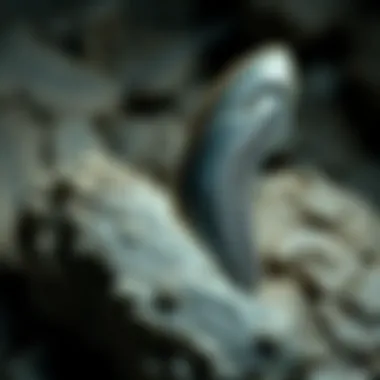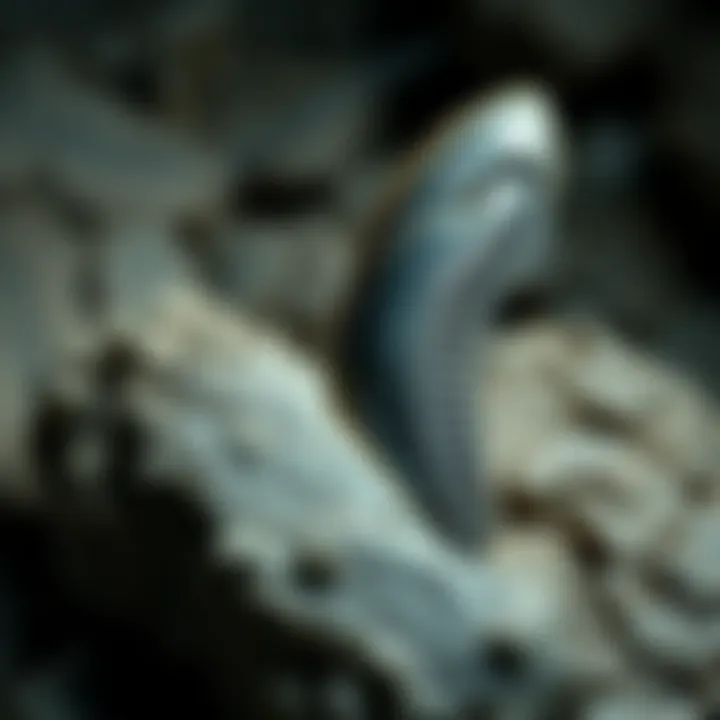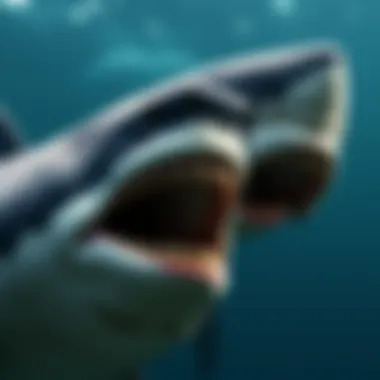Exploring the Reality of the Megalodon


Intro
The megalodon, often shadowy in our mythology and lore, ignites fascination much like an ancient shipwreck—mysterious and lost to time. This ancient predator has, over the years, become a hallmark of oceanic awe and wonder. With stories swirling around this massive shark, the question arises: Did megalodon truly exist? This article embarks on a journey through the deep waters of paleontology, aiming to uncover the truth behind this prehistoric titan.
A compelling analysis begins with the fossil records, revealing fragments of teeth and remnants that tell a tale of a creature that ruled the seas millions of years ago. As we journey deeper, we will sift through the cultural narratives about the megalodon, assessing how they intertwine with scientific evidence. With each layer peeled back, we move closer to understanding not just the megalodon's ecological role, but the human fascination that continues to captivate experts and enthusiasts alike.
Featured Collectible of the Month
Overview
This month, we spotlight a truly prized specimen for collectors—the megalodon tooth. These fossilized remnants, some measuring over seven inches in length, offer insight not only into the size of the creature itself but also serve as tangible connections to Earth's prehistoric oceans. Collectors prize these teeth for their size, serrations, and overall preservation, often showcasing them in specially-designed displays that mimic the megalodon’s formidable nature in real life.
Historical Significance
Megalodon teeth have been sampled as far back as the mid-1800s. When the first paleontologists began studying these remnants, it was a pivotal moment that led to revelation upon revelation about Earth’s marine history. The teeth are a bridge to the past, telling stories of a time when megalodon ruled the waves—over 2 million years ago. Each tooth not only showcases the impressive evolution of this species but also reflects the ecological shifts that our oceans have undergone since.
Collectors often seek well-preserved teeth, with those showcasing the finest serrations and no visible damage prized above others.
Identification Techniques
Visual Characteristics
Identifying a megalodon tooth requires a keen eye. These teeth are distinctive in shape, usually triangular and robust, with prominent serrations that look like tiny saw blades. The coloration can vary, typically showing shades from jet black to deep brown, often influenced by the minerals present in the sediment where they were found. A collector must also consider the size; adult megalodon teeth can reach impressive lengths of over seven inches, a size that alone distinguishes them from other shark teeth.
Resources for Identification
For collectors and enthusiasts eager to identify megalodon teeth, a plethora of resources are available. Here are some invaluable links:
- Wikipedia on Megalodon
- Britannica’s Entry on Megalodon
- Various forums on Reddit where collectors often share their finds and seek advice.
- Helpful articles from educational platforms such as Smithsonian and paleontology-focused sites like PaleoPlanet.
In summary, the megalodon remains a fascinating mystery amidst the most passionate discussions among paleontologists and fossil collectors. Understanding its existence, through both tangible evidence and the cultural myths surrounding it, enriches our appreciation for Earth’s dynamic history.
Prologue to the Megalodon
The megalodon, a word that conjures images of colossal teeth and fierce predation, sits at the intersection of scientific inquiry and cultural mythology. It’s not merely an ancient shark; it represents a puzzling chapter in the history of Earth’s oceans. In this section, we will explore the significance of understanding the megalodon, looking specifically at its definition and historical context to set the stage for a broader discussion.
Defining the Megalodon
Megalodon, scientifically known as Carcharocles megalodon, emerged as one of the largest fish to grace the planet’s oceans. Imagine a creature reaching lengths over 50 feet—more than three times the length of an average great white shark. Its teeth, long and serrated, could measure over seven inches in length, making them a formidable tool for catching prey.
Defining the megalodon goes beyond mere metrics; it involves exploring its anatomical features, behaviors, and ecological roles during its time. Paleontologists infer from fossil evidence that this apex predator dominated marine environments roughly 23 to 3.6 million years ago. Its size and predatory nature meant that it likely preyed on large marine animals, including whales, which makes it a key player in the prehistoric oceanic ecosystem.
Historical Context
When discussing the megalodon, it's crucial to understand its historical context. The megalodon is often associated with the Neogene period, a time rich with diverse marine life. As the climate changed and as tectonic plates shifted, the oceans transformed. Understanding these shifts provides insight into the eventual decline of this massive creature.
Interestingly, the megalodon thrived during an epoch when mammals like baleen whales began to flourish. This suggests a competitive ecosystem where adaptation was key to survival. While it is easy to romanticize the idea of a gigantic shark from the depths, the reality is that the megalodon's extinction also tells a story of environmental changes and evolutionary pressures that continue to resonate in today’s marine biology.
Fossil Evidence of the Megalodon
The excavation of fossil evidence is critical for understanding the megalodon, the largest shark that ever existed. These fossils not only provide insights into the size, diet, and behavior of this ancient marine predator, but they also help scientists piece together the ecological dynamics of ancient oceans. By studying megalodon fossils, researchers can explore how this formidable creature interacted with its environment and what factors contributed to its eventual decline. The fossil record plays a vital role in dispelling myths and establishing scientifically sound narratives about this giant shark's life.
Key Fossil Discoveries
Fossil discoveries of the megalodon primarily involve its teeth, which are often the most well-preserved parts of the shark due to the hardness of dental enamel. Over the years, paleontologists have unearthed thousands of teeth ranging from 1.5 to over 7 inches in length. These teeth exhibit unique characteristics such as triangular shapes with serrated edges, indicating an evolutionary adaptation for a powerful bite designed to tackle large prey.
Some notable finds include:
- Shark Tooth Hill in California, where numerous megalodon teeth have been found dating back to 15 million years ago.
- Fossil sites in South Carolina, including the Coastal Plain, which boasts concentrations of megalodon teeth dating back to the Miocene epoch.
- A remarkable find off the coast of Florida, where a massive megalodon tooth was discovered in sediments believed to be around 60 million years old.


These discoveries highlight how megalodon teeth are not just relics; they serve as powerful indicators of the ecological status of ancient marine life and the environments in which they lived. Notably, each tooth can provide clues about the predator's growth and development, as well as its hunting strategies during different life stages.
Geological Timeframe
Understanding the geological timeframe in which megalodon existed is crucial for contextualizing its evolutionary history. The megalodon lived during what scientists refer to as the Cenozoic Era, specifically from the early Miocene (around 23 million years ago) to the late Pliocene (around 2.6 million years ago). This was a period marked by substantial climatic shifts and marine biodiversity.
During this era, the Earth's oceans underwent massive transformations. The formation of ocean currents like the Gulf Stream and continental shifts due to tectonic movements influenced the distribution of marine species, including the megalodon. It thrived during warm periods, where an abundance of marine life, particularly larger prey such as whales, provided plentiful hunting opportunities.
The extinction hypotheses surrounding the megalodon stem from climatic changes that led to the cooling of ocean temperatures and, consequently, the shift in prey availability. As marine ecosystems transformed, megalodon populations dwindled, eventually leading to their disappearance from the fossil record.
In summary, the fossil evidence meticulously charts the megalodon’s existence, providing invaluable insights into its biological and ecological legacy. As researchers continue to analyze these ancient remains, they not only enhance our understanding of this fascinating creature but also contribute to the broader narratives of marine life's evolutionary history.
"Fossils serve as the time capsules of the past, preserving secrets of a world long gone but never forgotten."
For more detailed information on megalodon and its fossil evidence, consider checking resources such as Encyclopedia Britannica and Wikipedia.
In future discussions, we'll continue to unravel the mysteries locked within these fossils, exploring the debates they ignite within the scientific community and their lasting impact on paleontology.
Megalodon Characteristics
Understanding the characteristics of the megalodon is crucial for grasping its significance in marine history. This colossal predator once roamed the oceans and dominated its habitat, leaving an indelible imprint on the ecosystem. By exploring various aspects like its size, diet, and ecological role, we can piece together the puzzle of its existence. Clarity about the megalodon's attributes helps to untangle myths and enrich our understanding of ancient marine life, which can be just as relevant today as it was millions of years ago.
Size Estimates
The size of the megalodon has sparked fascination and debate among researchers, often leading to jaw-dropping estimates. Some scientists propose that this creature could have reached lengths of up to 60 feet (about 18 meters) or even longer. To put this in perspective, think about a bus – a standard city bus measures roughly 40 feet. Just imagine trying to swim alongside something even larger and more formidable!
Research methods used for estimating these sizes often rely on fossilized teeth, particularly the iconic large triangular specimens. A common approach is to extrapolate the size of the megalodon from its teeth, which have been found in various locations across the globe. Based on these finds, it’s suggested that the megalodon had a body length potentially exceeding any contemporary shark.
"Size is not just about length. The megalodon’s bulk would have given it a massive presence in oceans, which cannot be overlooked."
Moreover, paleontologists are eager to compare the size of the megalodon with other marine predators from its time, such as the great white shark. This comparison lends insight into how megalodon might have adapted to survive in an ever-changing marine ecosystem.
Diet and Feeding Habits
Diet plays a pivotal role in determining how a species interacts with its environment. The megalodon's diet is believed to have consisted primarily of large aquatic animals, including whales and other sizeable fish. This predatory behavior positions the megalodon at the apex of the marine food chain, where it served as a crucial regulator of marine fauna.
The hunting system of the megalodon likely involved unique physical adaptations; its serrated teeth were designed for grasping and tearing flesh rather than just capturing small prey. This feature emphasizes its efficiency as a predator. It is theorized that megalodon employed ambush tactics, possibly leveraging its size and strength to surprise and overpower unsuspecting targets.
Furthermore, fossil evidence suggests that these sharks were capable of a diverse diet, which might have included diving deep to hunt for squid or even scavenging remains of dead animals. Learning about their dietary habits not only uncovers how they thrived during their time on Earth but also offers a lens through which we can interpret their ecological significance.
In summary, megalodon's characteristics, from its imposing size to its formidable dietary habits, reveal much about its lifestyle and underscore its prominence in past ecosystems. For those who collect fossils or study marine life, understanding these attributes provides a richer context to the narrative of our oceans' history, making the megalodon both a captivating subject and a valuable focal point in environmental discussions today.
Paleontological Insights
Understanding the paleontological insights surrounding the megalodon is crucial for grasping its significance in the annals of marine history. This section will cover the contributions of research in this field and the ongoing debates that enrich our knowledge surrounding this ancient predator.
Research Contributions
The body of work regarding the megalodon's existence has been immense, drawing interest from a range of specialists. Paleontologists have dedicated years of research to uncovering fossil evidence that not only highlights the megalodon's size and characteristics but also places it within the broader context of marine evolution.
Key contributions include:
- Fossil Analysis: Numerous well-preserved teeth are critical in identifying the megalodon. Notably, the discovery of large teeth in areas like North America and Europe provides insight into its geographic distribution. These teeth, with some measuring over seven inches in length, suggest a formidable predator that once roamed vast oceans.
- Reconstruction of Ecosystems: By studying the fossil record, scientists have pieced together the ecosystems in which the megalodon thrived. Evidence indicates that it may have influenced the populations of other marine species. This dynamic interaction hints at its vital role in regulating marine environments over millions of years.
- Dating Techniques: Advanced radiocarbon dating techniques and stratigraphy allow researchers to narrow down the time frame of the megalodon’s reign. These findings help establish timelines that reveal how the species evolved, adapted, and ultimately faced extinction.
"The fossil record does not just tell us about the megalodon; it shows us the story of life in the oceans during its time."
Debates Among Scientists
The existence of the megalodon is not without contention. Within the scientific community, debates persist regarding the specifics of its biology, behavior, and the circumstances surrounding its extinction. Some crucial points of contention include:


- Size and Feeding Strategy: While many agree on its large size, estimates vary significantly. Some researchers argue that the megalodon could reach lengths of up to 60 feet, while others suggest more conservative figures. The uncertainty in size raises questions about the types of prey it targeted; did it only feast on large marine mammals, or could it have also been a generalist predator?
- Extinction Theories: Various hypotheses exist regarding why the megalodon became extinct. Climate change, competition with other species (such as great white sharks), and even shifts in prey availability are all suggested as contributing factors. However, no consensus has been reached, leaving room for continued exploration in paleontological studies.
- Cultural Interpretations: Interestingly, the megalodon has become a fixture in popular media, leading to a blurred line between scientific fact and myth. Some academics argue that this sensationalism can mislead the general public about the realities of prehistoric life. Thus, bridging the gap between serious science and engaging narrative remains a critical issue.
In summary, the paleontological insights surrounding the megalodon illustrate not just the creature itself, but also its implications on marine history and the interpretation of fossil records. By examining both contributions from research and ongoing debates, it's clear that the fascination with the megalodon will inevitably lead to more discoveries, unearthing deeper understandings of our planet's ancient past.
Cultural Impact of the Megalodon
The cultural resonance of the megalodon extends far beyond the scientific community, birthing a rich tapestry of media, myths, and public fascination. This ancient shark has captured imaginations, merging history with fiction to create a narrative that has influenced various forms of storytelling, from films to literature. Understanding its cultural impact provides insight into not just how the megalodon was perceived historically, but also how it shapes our current views about prehistoric life and marine ecology.
Representation in Media
The portrayal of the megalodon in media has transformed over the decades. Films like Jaws set a precedent for how sharks are depicted in popular culture. Yet, the megalodon emerges as a different beast entirely. In movies such as The Meg, the megalodon is ramped up from a terrifying predator to a gigantic spectacle, emphasizing our enduring fascination with size and power.
- Films: Movies frequently exaggerate the characteristics of this creature, focusing not only on its size but also on its predatory nature, which leads viewers to see it as a symbol of uncontrollable natural forces.
- Books: In literature, especially in adventure and science fiction genres, the megalodon often functions as a metaphor for the primal and the unknown. This symbolizes humanity’s fears of nature, reflecting a sense of adventure entwined with peril.
- Documentaries: Various educational documentaries, including those aired on National Geographic and the BBC, attempt to balance the sensationalism by presenting factual information about megalodon’s lifestyle and extinction, framing it as part of a larger narrative about marine life.
This duality in representation—where megalodon is both feared and revered—illustrates the complexity of human emotions toward dangerous creatures. It’s as if society grapples with the megalodon as both a magnificent relic of the past and a subject of horror.
Public Perception and Myths
The public perception of the megalodon has nurtured a garden of myths that flower in conversations and social media interactions. From the depths of the ocean to urban legends, the narrative surrounding the megalodon is rich with folklore and exaggeration.
"What if megalodons are still swimming out there?" is a recurring thought amongst enthusiasts, leading to countless discussions on online platforms.
Some prevalent misconceptions include:
- Survival Theories: Many believe that megalodons still exist in some hidden part of the ocean, often fueled by sightings claimed by amateurs or internet users sharing ideas on Reddit.
- Extreme Size Estimates: Public consciousness often inflates the size of the megalodon, with some claiming lengths of up to 80 feet, despite scientific estimates being around 40-60 feet.
- Cultural Icons: From t-shirts to toys, the megalodon has become a cultural icon, often trivialized or misrepresented, which distances the science behind paleontology.
By dissecting these myths, one sees how fear and fascination work hand-in-hand to shape perceptions of ancient predators. The megalodon becomes a meta-character of sorts, simultaneously a creature of deep concern and a playful representation of nature’s mysteries.
Conservation and Environmental Considerations
Understanding the conservation and environmental implications of ancient species like the megalodon can illuminate our approaches to modern marine ecosystems. Though the megalodon itself is extinct, the ecological lessons drawn from its existence and the environment in which it thrived provide critical insights. By studying such a formidable predator, we gain a better grasp of our own impact on marine life today.
Megalodon’s Ecosystem Role
The megalodon, Carcharocles megalodon, reigned as the top predator in its time, influencing the marine ecosystems of the Cenozoic Era profoundly. Its presence in the ocean set the stage for a complex web of life. Top predators like the megalodon are crucial because they help maintain the balance of species within their environment. Without them, we risk overpopulation of certain species, which can lead to depletion of resources and degradation of habitats.
- Prey Species Dynamics: The megalodon primarily preyed on large marine mammals such as whales—its formidable size allowed it to shape the populations of these prey species. This predatory influence is akin to what we observe with today's apex predators, such as sharks and orcas.
- Ecosystem Diversity: By controlling the populations of large marine mammals, the megalodon indirectly contributed to the diversity of marine life. Species that were kept in check flourished alongside others, a balance that is essential for healthy ecosystems.
- Indicator of Ecological Health: The presence of large predators often signals a thriving environment. When examining fossilized megalodon remains, we can infer the types of habitats and conditions of the oceans at that time. Understanding these factors helps scientists today to evaluate the health of contemporary marine ecosystems.
"The extinction of apex predators like the megalodon can lead to severe ecological consequences, resulting in cascading effects throughout marine environments."
Lessons for Modern Marine Conservation
The legacy of the megalodon presents a crucial reminder for contemporary marine conservation efforts. As we navigate the challenges posed by human activity—overfishing, pollution, climate change—reflecting on the role of ancient megafauna can guide us toward more sustainable practices. Here are a few lessons learned:
- Importance of Protecting Apex Predators: Modern conservationists recognize that protecting apex predators is essential for maintaining ecosystem balance. Their decline leads to an imbalance that can endanger various species down the food chain.
- Habitat Preservation: The fossil record emphasizes the need to safeguard crucial marine habitats that support diverse marine life. Wetlands, coral reefs, and estuaries help to foster biodiversity, along with providing critical services such as nursery areas for young fish.
- Research and Technology: Innovative technologies, such as DNA analysis and satellite tracking, enable scientists to better understand marine life and their habitats, just as paleontological methods have helped elucidate the story of the megalodon.
- Community Engagement: Protecting marine environments requires the involvement and education of local communities. Just as knowledge of the megalodon's impact on its ecosystem can inspire conservation efforts, understanding today’s challenges fosters excitement and activism among the public and stakeholders.
As we study the megalodon's ecological role, we must convey such findings to engage with cutting-edge conservation strategies. It's integral to promote a future where marine ecosystems thrive, much like during the epoch of the megalodon.
Skepticism and Scientific Critique
Skepticism and scientific critique serve as the backbone of any rigorous investigation, especially when it comes to a fascinating yet controversial subject like the megalodon. In evaluating its existence, embracing skepticism allows scientists to sift through evidence critically, separating fact from lore. These considerations underscore the necessity of maintaining a critical eye toward both fossil evidence and the interpretations that follow.
Challenges in the Fossil Record
The fossil record presents a myriad of challenges when it comes to understanding ancient marine creatures, including the megalodon. One of the most significant hurdles is preservation bias. Fossils predominantly consist of hard parts—like teeth and bones—while softer tissues rarely survive the test of time. This is crucial for the megalodon, as we often rely on its teeth, which, while impressive, only provide a partial picture of its biology.
Moreover, the geological timeline complicates the matter further. Most megalodon teeth found belong to different layers of sediment, created during various environmental conditions. This makes it tricky to pinpoint not just the megalodon's existence in geological time but also its interaction with other species and ecosystems.
- Fossil fragmentation: Parts may be broken or eroded, leading researchers to draw incomplete conclusions.
- Environmental factors: Changes in sea levels and temperatures could have influenced where fossils were deposited.


Researchers must tread carefully when interpreting these fossil finds—they can only speculate on ranges of behavior and ecology based on fragmented records. A proper understanding of these gaps in the fossil history is essential for anyone attempting to unravel the mysteries surrounding the megalodon.
Misinterpretations of Evidence
Equally as challenging is the misinterpretation of available evidence. In the quest to establish the megalodon as a real creature, some individuals may rush to conclusions based on anecdotal evidence or a misreading of skeletal structures. The temptation to overstate the significance of certain findings can cloud judgment, leading to extravagant claims that ultimately do more harm than good.
Some common pitfalls include:
- Overgeneralizing species traits: Just because a tooth was found does not definitively mean it belongs to a megalodon. Mistakes in taxonomy abound when clear identification methods are overlooked.
- Ignoring ecological context: Findings must be viewed within the larger tapestry of historical biodiversity. Simply suggesting that a megalodon thrived based solely on dental finds without considering what else was living at the same time can lead to skewed perceptions of the ecosystem.
"The interpretation of evidence is almost as crucial as the evidence itself; misconceptions can easily spiral into urban myths."
For serious rock and fossil collectors, grasping these points is essential. Being discerning about sources of information and approaching each piece of evidence with a critical thought process can better illuminate the ancient world—teasing out the truth hidden within layers of sediment and time.
Future Research Directions
The research surrounding the megalodon fuels not only scientific inquiry but also a wider conversation about marine biology and conservation. While we’ve made strides in understanding this colossal predator, the journey is far from over. New avenues of research are opening up, driven by both technological advancements and the continuously evolving questions within the field. Exploring these future directions is vital for grasping the complete picture of the megalodon’s ecological niche and historical existence.
Innovative Technologies in Paleontology
This section sheds light on how innovative technologies are revolutionizing paleontological research. One of the significant advancements includes the use of computed tomography (CT) scanning. This non-destructive technique allows researchers to examine fossilized remains internally, thus preserving the integrity of delicate specimens. Furthermore, 3D modeling has emerged as a critical tool. It enables scientists to recreate biological structures, allowing for dynamic studies of how megalodon may have interacted with its environment.
Additionally, the field has also benefited from genomic sequencing. While obtaining DNA from ancient specimens remains a challenge, researchers are hopeful. Sequencing and analyzing the genomes of related species can yield clues about the megalodon’s genetic makeup and evolutionary history. The application of machine learning algorithms to analyze large datasets of fossil records further enhances our ability to uncover patterns and correlations in ancient marine life.
"Each technological advancement offers a new lens through which the past can be interpreted, opening doors to questions previously deemed impossible to answer."
The integration of these technologies not only improves our understanding of the megalodon but also illuminates broader themes in evolutionary biology. Organizations like the American Geophysical Union (agu.org) and institutions such as the Smithsonian National Museum of Natural History provide relevant resources and studies on these technologies and their applications in paleontology.
Expanding Research Questions
The megalodon's story invites scientists to explore a multitude of questions that go beyond the confines of traditional research. One crucial question is the environmental pressures, such as climate change and oceanography, that may have influenced its extinction. Analogies can be drawn from modern-day sharks, analyzing how shifting ocean temperatures affect their behaviors and populations. Moreover, integrating climate data from the Earth’s geological past will allow researchers to hypothesize the megalodon’s adaptability—or lack thereof—during significant climatic shifts.
Another avenue worth exploring is its social behavior. Did the megalodon hunt alone, or could it have exhibited pack-like behaviors similar to some contemporary marine predators? Investigating this could require an interdisciplinary approach involving anthropology and behavioral ecology, thereby enriching our understanding of not just the beast itself, but its interactions with the ecosystem at large.
Furthermore, the exploration of cultural narratives tied to the megalodon opens an entirely different dimension. Why does this ancient shark still resonate with society? Studying its presence in folklore and modern media helps in understanding how species can influence human culture and vice versa. The dialogues surrounding the megalodon serve as a reminder of how natural history intertwines with human storytelling.
It is this blend of technology and inquiry that shapes the future of megalodon research. Engaging with these expansive questions pushes scientists to think critically about their findings and encourages a more nuanced perspective on the ancient world.
For those interested in learning more about the resources available for ongoing research in this field, websites like edgescience.com, and scientific publications such as Paleobiology (paleobiology.org) offer valuable insights into ongoing studies and emerging technologies.
The End
The importance of the conclusion in this article lies in its synthesis of the historical, paleontological, and cultural inquiries surrounding the megalodon. After thoroughly dissecting the evidence and examining various perspectives, it becomes clear that the megalodon, while no longer roaming the oceans, still has a substantial influence on our understanding of marine ecosystems. The artifacts from its past not only contribute to paleontological discourse but also fuel modern mythologies that captivate the imagination.
Summation of Findings
Throughout this investigation, we have uncovered several critical aspects regarding the existence of the megalodon. Key points include:
- The fossil record, which suggests the megalodon lived from about 23 million years ago to approximately 2.6 million years ago, providing a glimpse into its vast presence in ancient oceans.
- The unique characteristics of the megalodon, such as its impressive size and ferocious predatory behavior, which reveal significant evolutionary traits.
- The cultural interpretations, ranging from simple children's stories to complex documentaries, show how the megalodon continues to live on in public consciousness.
These findings indicate not only the fossil evidence that supports its historical existence but also the ongoing debates among scientists that highlight a gap between scholarly perspectives and popular beliefs.
The Megalodon in Modern Understanding
In modern consciousness, the megalodon stands as a symbol of prehistoric wonder and fear. It's more than just an ancient shark; it embodies the obsession with the past's mysteries. Popular media, from documentaries to fictional portrayals, often sensationalize its size and ferocity, sometimes straying far from scientific accuracy. This leads to the continuous evolution of myths surrounding it.
Moreover, the increase in interest surrounding topics like climate change and marine conservation has caused some to reexamine the megalodon’s ecological significance. By understanding the potential reasons behind its extinction, we can draw parallels to the threats facing modern marine life, further emphasizing the need for conservation efforts today.
"The past is never dead. It's not even past." - William Faulkner
As we continue to research and delve into the mysteries of our world's history, the megalodon remains a cornerstone in discussions about marine biology and conservation. To learn more about the megalodon, check out these resources:
- Wikipedia - Megalodon
- Britannica - Megalodon
- For more engaging discussions, visit relevant forums on Reddit
- Explore marine conservation perspectives at various government sites, like NOAA.
Ultimately, understanding the megalodon enriches our grasp of evolutionary history and echoes the present-day challenges that marine life faces.



